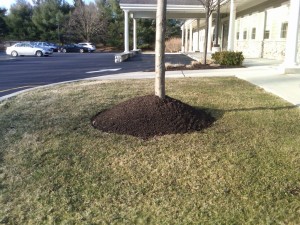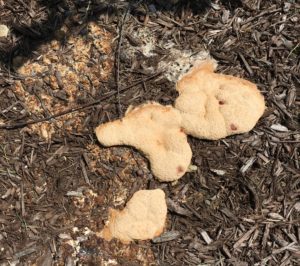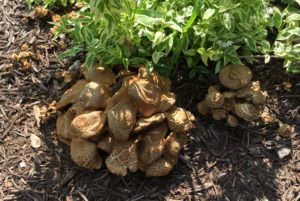Hello, fellow lovers of all things green. It’s mulch time, and John from Andover, NJ, asked what kind of mulch to use. First and foremost, stay clear of trunks and stems to prevent disease. That’s my polite way of saying no volcano mulch, please. To avoid mushrooms in the garden, choose a quality mulch and apply it correctly. But if impacted, there are ways of fixing funky fungi that can grow in mulch. Here’s how:
Choosing the Best Mulch

Please Stop Mulch Volcanos
There once was a trend and using Cocoa Mulch, which can be toxic to pets, and the sweet smell can attract wild animals, so best to stay clear. Then there’s the controversial Dyed Mulch, often made from recycled wood products such as wood pellets, old decks, and other construction debris, which may have harmful chemicals. Then there’s the dye they use to camouflage the wood. Hence, Dyed Mulch is another stay-away to keep plants healthy. Recall how hot it is to walk barefoot on a blacktop driveway. The same goes for Black Mulch around plants, impacting plant health by heating the roots.
I prefer Cedar and Hemlock mulch, which have fewer mold spores than other hardwood mulches and don’t break down as quickly. Leaf mold makes a fabulous mulch, as discussed in Leaf Mold—Better than Mulch.
Jeanne’s Fungi Dilemma
Speaking of spores, Jeanne shared a fungi dilemma, an alien-looking plethora of mushrooms amongst her garden mulch. Mushrooms are the fruit of valuable spores that decay organic material and recycle nutrients back into the soil, which is beneficial for plants. However, in volumes, they’re unsightly in the garden. The good news is most mushrooms are not toxic and do not cause disease, though a few are poisonous if eaten, so keep curious critters and kids away.

Slime Mold looks like a dog hurled (sorry if you’re eating breakfast)

Mushrooms are good for our earth but unsightly in the garden.
Many types of mushrooms can evolve in your mulch, from the classic toadstool to smelly fingerlike stinkhorns that attract insects. There are the puff balls I loved to pounce as a kid to release black clouds of spores. Then there’s the bright pink, orange, or yellow slime mold that looks like a dog hurled. Sorry if you’re eating breakfast.
Groups of birds’ nests mushrooms look like little eggs inside cups. It’s the dreaded artillery fungus with clusters of minute orange-brown or cream cups with black specks in the center, which shoot tarlike spores onto siding, walkways, and even on cars that are impossible to remove.
How to Prevent Mushrooms in Mulch
Mulch should never be more than two or three inches, as too much inhibits air circulation needed for root health. Plus, too-thick mulch will create a mat that hinders moisture from getting through to roots, and it kills microorganisms that prevent spores from fruiting, meaning you’ll have more mushrooms. Moisture, cold temperatures, and shade provide an ideal environment for mushrooms.
Hand watering at the roots or drip irrigation rather than sprinklers will help limit mushroom colonies. While fungicides are used in lawns to treat short-lived fungi like leaf spot and root rot, they won’t help fungi that create mushrooms. Instead, rake mulch periodically to interrupt the fungal cycle, inhibiting them from fruiting. If mushrooms have formed, remove them and toss them into a bag to dispose of them to prevent further spreading of spores.

Too thick mulch encourages mushroom growth.
Mushrooms prefer acidic soil. Adding lime can make the soil more alkaline, but it would negatively affect other acid-loving plants. (Many folks apply lime routinely: please don’t without testing the soil first, which you can do at your local extension office.)
How to Fix Funky Fungi Dilemmas in Mulch
They say two tablespoons of baking soda mixed with a gallon of water won’t change the soil’s chemistry or pH, but it will disrupt the ideal conditions for fungal growth.
While you can refresh decaying mulch by adding a half-inch of fresh mulch on top, once mushrooms become running amok, it’s time to remove and install new mulch. Add the old mulch to the compost pile, turning it every few months to create compost soil.
Organic compost soil (or leaf mold) instead of mulch is a nourishing alternative for your plants. It’s already broken down, so mushrooms won’t have much to feed on. Penn State researchers discovered blending four parts of mushroom compost, also sold as mushroom soil, with ten parts of mulch significantly impedes artillery fungus and other annoying fungi because it contains beneficial microbes that destroy it. Plus, mushroom soil, the byproduct of edible mushroom production, will boost plant growth. If you can’t beat em, join em.
Garden Dilemmas? Askmarystone@gmail.com and your favorite Podcast App.
There’s more to the story in the Garden Dilemmas Podcast (a soothing 10 minutes):
Links to related stories you’ll enjoy:
Penn State Extension: What Is Growing in My Landscape Mulch? Mushrooms, Slime Molds, and Fungus with terrific photos of funky fungi found in mulch.



There’s no reason at all to try to kill or suppress fungus in your mulch. Any mushrooms that fruit from the mulch that has been colonized by mushroom mycelia won’t last for very long. Mushrooms are just the fruiting bodies of the organism in the substrate.
Also, slime molds are not mushrooms, or any other sort of fungus, including mold — they are protists.
Thanks for sharing. I agree by and large, although the sticky black spores of artillery fungus can wreak havoc on houses. And I find the excess of fungus a sign of poor quality, often dyed, mulch. Fungus serves an essential role in our world. I like using Leaf Mold instead of mulch, with Hemlock Mulch and Pine Nuggets being my next favorites.
I thought Slime Mold was mold – common names can be so misleading. I had to look up protists. “a single-celled organism of the kingdom Protista, such as a protozoan or simple alga.” Per Oxford Dictionary. “Protists are a diverse collection of organisms that do not fit into animal, plant, bacteria or fungi groups.” – Per LiveSciencc.com.
There’s much to learn in the Garden of Life. Thank you for sharing your knowledge, Mary
If you have mushroom fruiting bodies in your compost, the compost is likely rather extensively colonized — so this makes it somewhat less likely that a species of the genus Sphaerobolus (“shotgun fungus” – a basidiomycete) has gained a foothold in the mulch, because it would be competing with the species that’s producing the mushrooms.
I think most people would like their mulch to eventually break down and deliver some value to their soil, for their plants. Mushrooms break down lignin, and pretty much nothing else can. Fungus in your mulch is, for the most part, a good thing.
So interesting. Thank you for graciously sharing your knowledge, Mary Stone